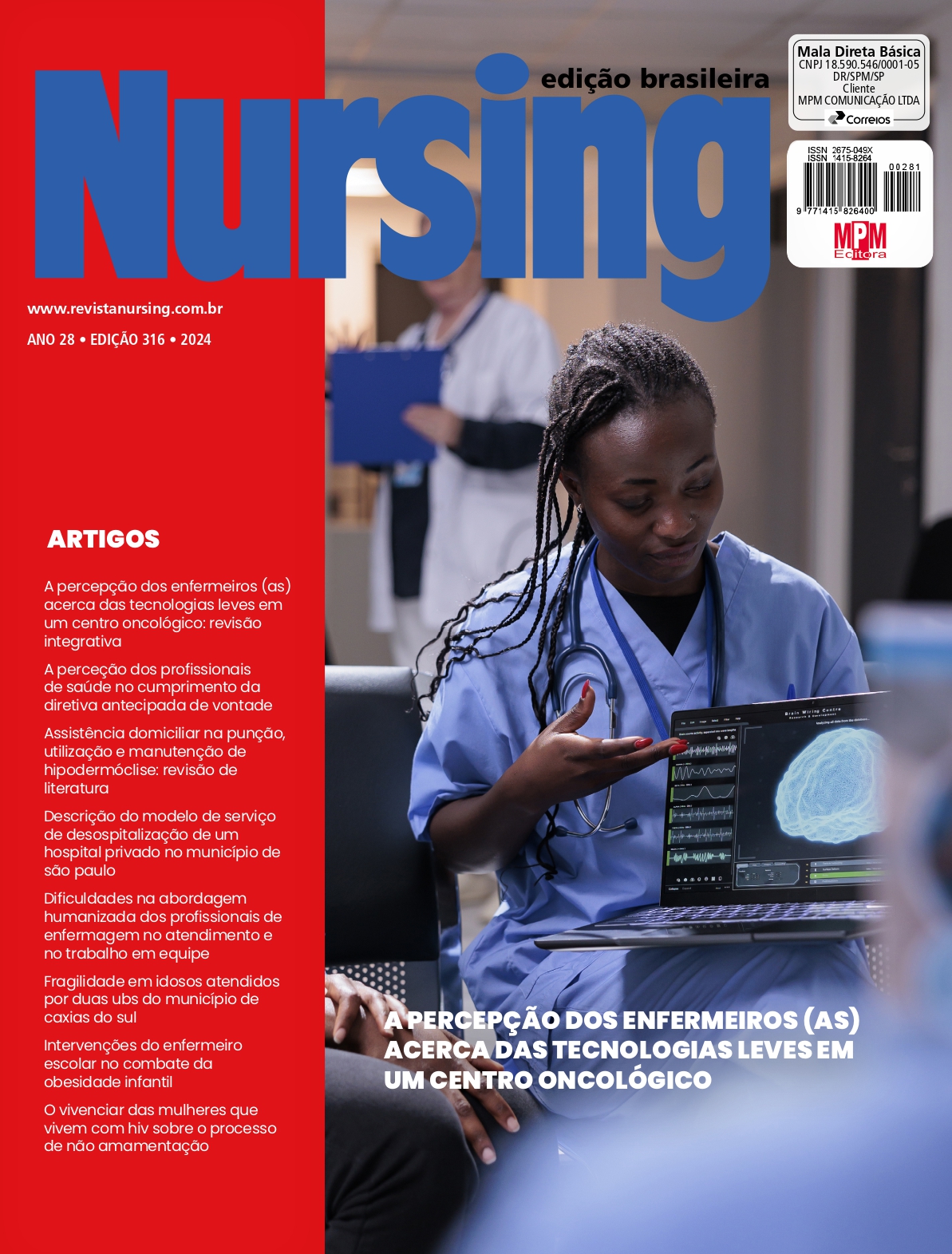HOME ASSISTANCE IN PUNCTURE, USE AND MAINTENANCE OF HYPODERMOCLYSIS: LITERATURE REVIEW
DOI:
https://doi.org/10.36489/nursing.2024v28i316p10157-10161Keywords:
Assistência de Enfermagem, Resultados de cuidados críticos; Unidades de terapia intensiva; Ansiedade; Depressão.Abstract
Nursing care is based on scientific knowledge combined with practical knowledge with the main objective of providing the best care to the patient, providing comfort and symptom relief. The present study aimed to understand the puncture technique and maintenance of the use of hypodermoclysis in the home environment in the elderly population. This is an integrative literature review in which a total of 05 (five) records were identified meeting the inclusion criteria of this review. The technique is likely to have minimal complications, with a high success rate in the elderly in palliative care and the very elderly and with a success rate of absorption into the subcutaneous tissue of 88% after one hour of infusion. It is concluded that the therapy is valid for the elderly population at home, but more studies are needed in this area as the search was limited to a few records.
References
Década do envelhecimento saudável. OPAS/OMS, 2020 - 2030, 2023.
Cardoso DH, Mortola LA, Arrieira ICO. Terapia subcutânea para pacientes em cuidados paliativos: a experiência de enfermeiras na atenção domiciliar. J Nurs Health [Internet]. 2016; [citado em 2023]. Disponível em: [https://doi.org/10.15210/jonah.v6i2.6478].
Saganski GF, Freire MH. Hipodermóclise como tecnologia integrativa ao processo infusional em crianças. Enferm Foco. 2024;15:e-202412.
Mendes KDS, Silveira RCCP, Galvão CM. Revisão integrativa: método de pesquisa para a incorporação de evidências na saúde e na enfermagem. Texto Contexto Enferm [Internet]. 2008;17(4):758-64. Disponível em: [https://doi.org/10.1590/S0104-07072008000400018 ]
Souza MT, Silva MD, Carvalho R. Revisão integrativa: o que é e como fazer. Einstein. 2010;8(1):102-6.
Higgins JPT, Green S. Cochrane handbook for systematic reviews of interventions. Version 5.1.0. London: The Cochrane Collaboration; 2011.
Martins SB, Cordeiro FR, Zillmer JG, Ameira ICO. Perfil clínico e sociodemográfico de adultos hospitalizados em cuidados paliativos. REUFPI [internet]. 2022. Disponível em: [https://doi.org/10.26694/reufpi.v10i1.766].
Vidal M, Hui D, Williams J, Bruera E. A prospective study of hypodermoclysis performed by caregivers in the home setting. J Pain Symptom Manage. 2016;52(4):501-508. Disponível em: [10.1016/j.jpainsymman.2016.04. 10.1016]
Coelho TA, Wainstein AJ, Drummond-Lage AP. Hypodermoclysis as a strategy for patients with end-of-life cancer in home care settings. Am J Hosp Palliat Care. 2020;37:123-129. Disponível em:[https://doi.org/10.1177/104990911989740]
Oliveira AT, Santos C. Percepciones de los cuidadores familiares sobre el uso de la hipodermoclisis en el hogar. Rev Enferm Actual. 2020;(38):1-12. Disponível em: [http://dx.doi.org/10.15517/revenf.v0i38.38509]
Moher D, Liberati A, Tetzlaff J, Altman DG, The PRISMA Group. Preferred Reporting Items for Systematic Reviews and Meta-Analyses: The PRISMA Statement. PLoS Med. 2009;6(7):e1000097.
Danielsen AM, Jodal L, Riis JK, Karmisholt JS, Valdórsson O, Jørgensen MG, Andersen S. Absorption rate of subcutaneously infused fluid in ill multimorbid older patients. PLoS One. 2022;17:e0263752. Disponível em:[https://doi.org/10.1371/journal.pone.0275783]
Souza RE, Mendonzi YQ, Ferraciolli EJ, Simino GPR, Gouveia VR, Guimarães GL. Incidence and adverse events of hypodermoclysis in the elderly in palliative care. Rev Enferm Cent-Oeste Min. 2023;13:e2023.
Gabriel J. Subcutaneous fluid administration and the hydration of older people. Br J Nurs. 2014;23(14):768-772. Disponível em:[ https://doi.org/10.12968/bjon.2014.23.Sup14.S1]
Hughes L, Smith T, Horne J, et al. Hypodermoclysis performed by caregivers in the home setting. J Pain Symptom Manage. 2016;52(4):501-508.
Silva RM, Araújo ACM, Furini CRG, Figueiredo AEPL, Urbanetto JS. Analysis of intravenous therapy and hypodermoclysis in hospitalized older adults. Rev Enferm UFSM. 2023;13:1-19. DOI: 10.5902/2179769284049








